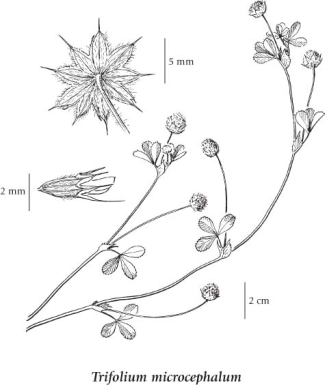Trifolium microcephalum Pursh
small-headed clover (smallhead clover)
Fabaceae (Pea family)
Introduction to Vascular Plants
small-headed clover (smallhead clover)
Fabaceae (Pea family)
Introduction to Vascular Plants
Species Information
General:
Annual herb from fibrous roots; stems 1 to several, decumbent to erect, 10-70 cm long, long wavy-hairy.
Leaves:
Alternate, palmately compound; leaflets 3, wedge-egg-shaped, notched at the tip, 1-2.5 cm long; stipules egg-shaped, sometimes bristle-tipped, fine-toothed, green, 1/2 as long as the leaflets.
Flowers:
Inflorescence a dense, globe-shaped, long-stalked head, 5-10 mm wide, of 7 to 60 pea-like flowers, the heads set in long-hairy, cup-shaped, lobe-margined involucres, the lobes papery-edged and mostly not toothed but bristle-tipped; corollas pink to white, brown in age, 3-6 mm long; calyces hairy, 4-7 mm long, the awl-shaped teeth bristle-tipped, equalling or longer than the 10-veined tube and the lower teeth often surpassing the corolla.
Fruits:
Pods, egg-shaped to ellipsoid, 2-3 mm long, usually rupturing the calyces at maturity; seeds 1 or 2.
Illustration

If more than one illustration is available for a species (e.g., separate illustrations were provided for two subspecies) then links to the separate images will be provided below. Note that individual subspecies or varietal illustrations are not always available.
Illustration Source: The Illustrated Flora of British Columbia
Ecology
Ecological Framework for Trifolium microcephalum
The table below shows the species-specific information calculated from
original data (BEC database) provided by the BC Ministry of Forests and Range.
(Updated August, 2013)
The table below shows the species-specific information calculated from
original data (BEC database) provided by the BC Ministry of Forests and Range.
(Updated August, 2013)
| Site Information |
Value / Class |
||
|
Avg |
Min |
Max |
|
| Elevation
(metres) |
166 | 31 | 490 |
| Slope
Gradient (%) |
45 | 7 | 210 |
|
Aspect (degrees) |
180 | 23 | 360 |
| Soil
Moisture Regime (SMR) [0 - very xeric; 4 - mesic; 8 - hydric] |
1 | 0 | 3 |
| Modal
Nutrient Regime
Class |
B | ||
| #
of field plots species was recorded in: |
66 | ||
| Modal
BEC Zone Class |
CDF | ||
|
All BEC Zones (# of stations/zone) species was recorded in |
CDF(13), IDF(1) | ||
|
Source:
Klinkenberg 2013
|
|||